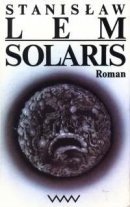Friday
Mar312006
Stanislaw Lem: The Passing of a Deep Spirit
 Friday, March 31, 2006
Friday, March 31, 2006  Stanislaw Lem, the great Polish "science fiction" writer died on March 27, 2006, at the age of 85. Two of Lem's works have played a role in the Chaos and Fractals course, and I describe the connection below. First, though, must be a tribute to this extraordinary writer.
Stanislaw Lem, the great Polish "science fiction" writer died on March 27, 2006, at the age of 85. Two of Lem's works have played a role in the Chaos and Fractals course, and I describe the connection below. First, though, must be a tribute to this extraordinary writer.Even though I know many who read, or have read a great deal of science fiction, I know very few who have read any of Lem's works. This is very odd, given that Lems' works have been translated into over 40 languages, with an estimated 27 million sold. (Some do read and prosper: Will Wright, the creator of the wildly popular SimCity simultaion game credits Lem's The Cyberiad as inspiration. )
With sci-fi readers (in the U.S., at least) not paying attention, what hope is there for more readership of this essential 20th-century author who is usually listed as I wrote above - a science -fiction writer, only without the quotes.
It has always been unfortunate that Lem's works are described as science fiction. This is itself a fiction. Lem - a brilliant scientist, writer, and thinker - told wonderful tales with an unnerving mixture of darkness, humor, philosophy, and theology that just happened to be placed deep in space, or inside a computer. While the location and time period of his stories are essential to their plots, Lem's stories are often more relevant to our current time and place because of his ability to paint rich characters in situations that are paradoxically both imaginable and impossibly strange.
 Lem's life as a scientist and writer growing up in Poland, through Nazi occupation and Soviet rule, is much of the reason for his chosen genre, as described in the Times of London obituary -
Lem's life as a scientist and writer growing up in Poland, through Nazi occupation and Soviet rule, is much of the reason for his chosen genre, as described in the Times of London obituary - He began to write fiction, his first works being in the tradition of socialist realism acceptable to the authorities. But he graduated to literary "fantasies", which he succeeded in hoodwinking the humourless and dogma-bound authorities into believing were innocuous, though they were in fact highly subversive and satirical.I first read Lem in 1983, when my best friend, Eric Törnqvist, gave me a copy of Solaris as a birthday gift and demanded that I read it. To this day it remains not just the greatest "science fiction" that I have ever read, but one of the best books I have ever read. It is a book in which there is no action of the type usually associated with a sci-fi stories. Instead, Solaris chronicles centuries of observation of a liquid planet and its seemingly non-descript moons, a planet that may be sentient, and may be malicious. With this simple idea , an idea that seems to present little opportunity for rich novelistic treatment, Lem writes a psychological study that is rich in horror, humor, and sharp observations of humanity in the face of the unknown.
(I'm probably not alone among Solaris readers who would never imagine it could be made into a successful film. In 2002, Stephen Soderbergh directed and released a film version of Solaris, starring George Clooney. This was the second time Solaris had been made into a movie. It was first made by Andrei Tarkovsky in 1972. I have not seen these films. Lem apparently did not like either of these treatments, and is reported to have walked out on both.)
And now the connection between Lem and Chaos and Fractals..

Solaris fractalThere is one scene in Solaris that I always think of when teaching Differential Equations or Chaos and Fractals. Occasionally, streams of liquid shoot from the surface of the the liquid planet, freezing/crystallizing briefly into shapes that are impossibly complex, fragile, and mesmerizing. After many years of analysis, scientists come to believe that these shapes are the visualization of the solutions to certain non-linear equations. Even though Solaris was written in 1961, well before the Mandelbrot set and the work of Ruelle and Takens on systems of non-linear differential equations , I can't help but imagine that the liquid structures are fractal-like, in their infinite complexity, and suggestive of the strange attractor at the heart of chaos theory.
The deeper link between Lem and Chaos and Fractals is Non Serviam, one chapter from Lem's 1971 A Perfect Vacuum. This is an extraordinary book - it is a set of fictitious book reviews of fictitious books, with each review written as an in-depth New Yorker-length essay. With wonderful recursion, the book also contains a review of itself. (Click here for a real review of this book of fictitous reviews of fictitious books.)
Non Serviam is a review of a recently "published" book on personetics - the study of personoids - artificially-intelligent beings that are created via software that reside in computer memory, and who grow, mutate, and replicate in a universe that exists solely on a mathematical substrate.
 Of tales of artificially produced personalities that include Frankenstein and I Robot, Non Serviam is at the far end of the continuum, the ultimate story in this genre. Lem's brilliance allows him to imagine that, with true personoids, consciousness will be guaranteed, along with a concomitant burgeoining of philosphy and theology among them. From the researcher whose work is described in Non-serviam:
Of tales of artificially produced personalities that include Frankenstein and I Robot, Non Serviam is at the far end of the continuum, the ultimate story in this genre. Lem's brilliance allows him to imagine that, with true personoids, consciousness will be guaranteed, along with a concomitant burgeoining of philosphy and theology among them. From the researcher whose work is described in Non-serviam:A "world" for personoid "inhabitants" can be prepared in a couple of hours... A specific personoid activity serves as a triggering mechanism, setting in motion a production process that will gradually augment and define itself; in other words, the world surrounding these beings takes on an unequivocalness only in accordance with their own behavior... From four to seven personoids are optimal, at least for the development of speech and typical exploratory activity, and also for 'culturization'... It is possible to 'accommodate' up to one thousand personoids... Many different philosophies (ontologies and epistemologies) have arisen among them...Lem brings a scientific/philosophical objectivity to the inevitable creator/creation tension:
I can enlarge their world or reduce it, speed up its time or slow it down, alter the mode and means of their perception; I can liquidate them, divide them, multiply them, transform the very ontological foundation of their existence...I use this reading in conjunction with The Mathematical Universe by John Barrow (see my recent post on Barrow and the Templeton Prize.) Students are then asked to identify their veiw of the essential nature of mathematics in the universe. Non Serviam provides a case study in which there is a mathematical universe is given a priori . (For student rections to these works, visit the September 2005 archives.)
There are many more terrific stories by Lem, and I recommend as another of my favorites Memoirs Found in a Bathtub.
Lem was truly described as "one of the deep spirits of the age".
There are an enormous number of informative Lem sites on the web. Start with the Nancy Street Network in Australia for a brief review of almost all of Lem's books (and a good deal of other pages devoted to other "science-fiction" writers.) Then check out Vitrifax: The writings of Stanislaw Lem by Matt McIrvin and a study guide for Solaris by Paul Brians, in the English Dept. of Washington State University, who teaches an online course in science fiction.
Finally, a beautiful obituary and testimonial to Lem can be found at the Waggish blog.
(The Solaris Fractal is from área fractal , a Spanish site.)


Reader Comments